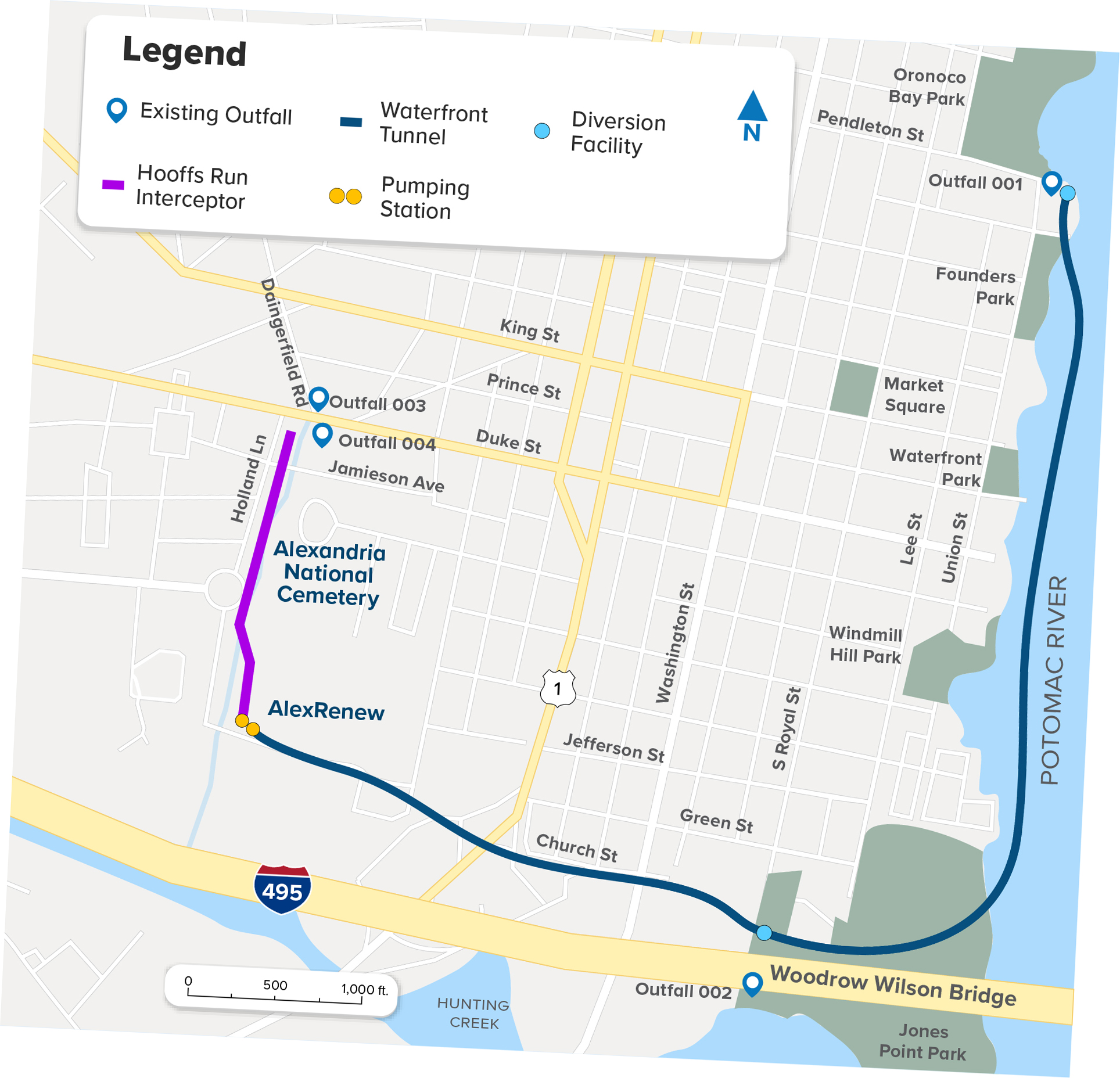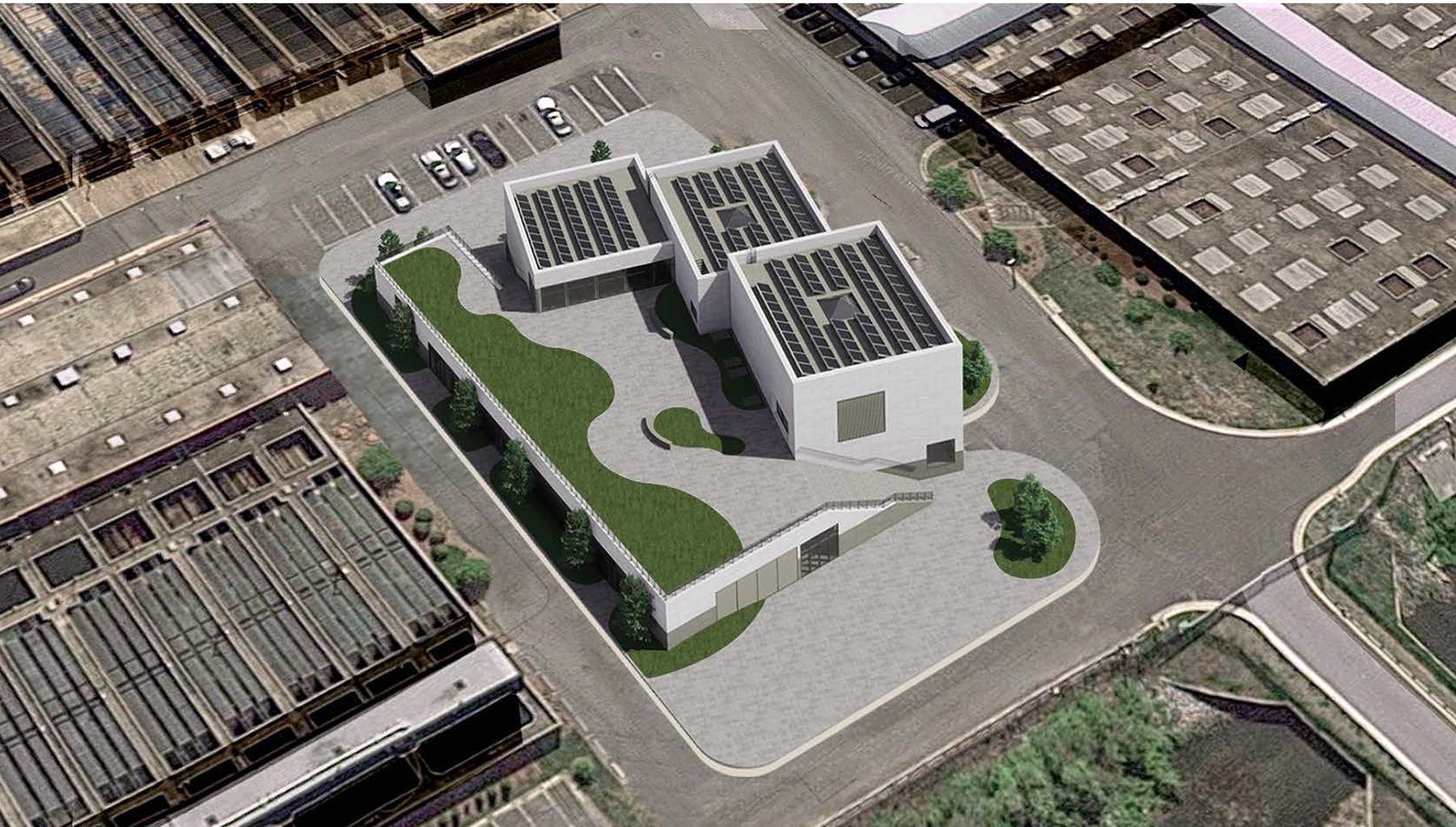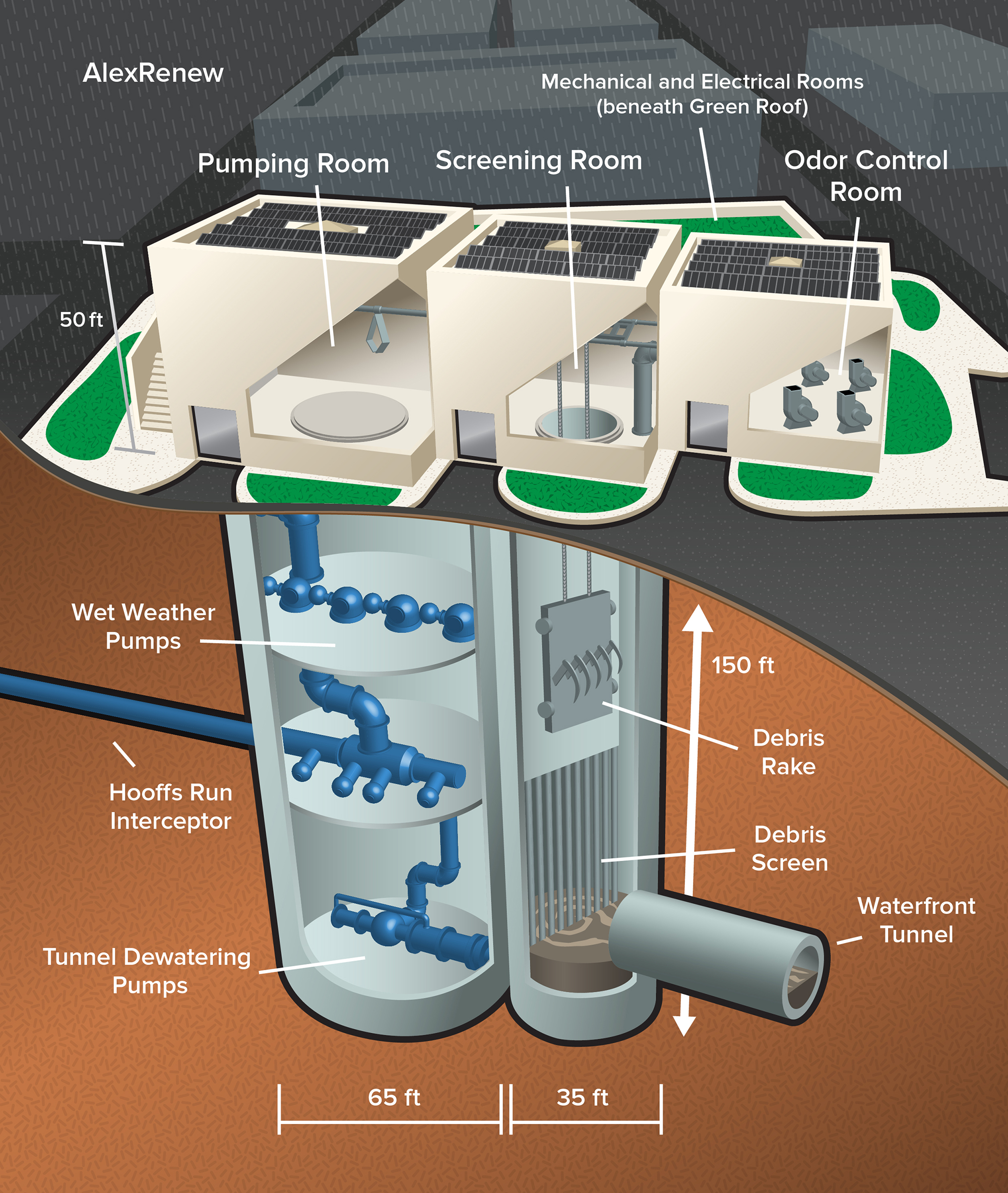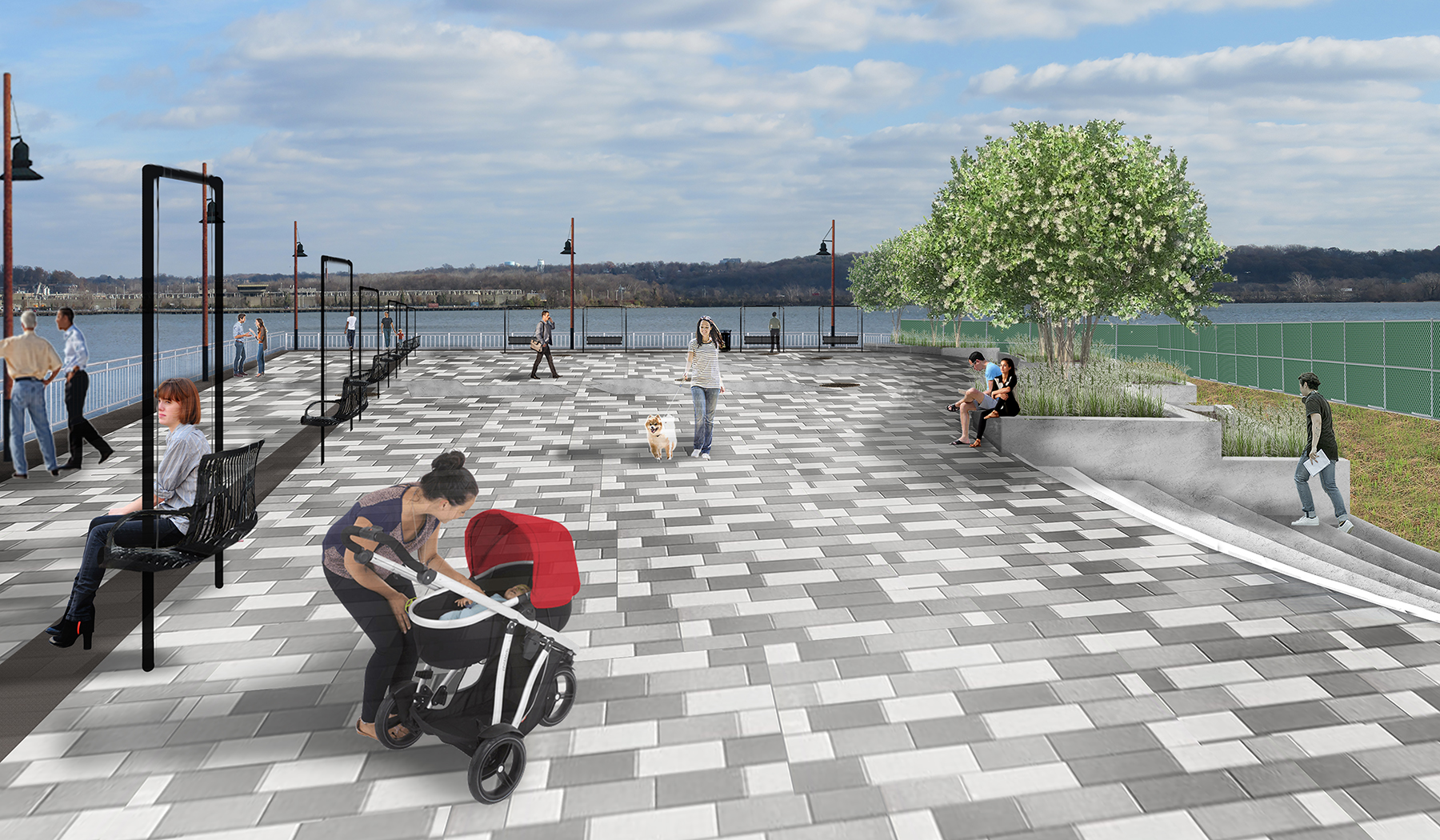Large-scale efforts to reduce combined sewer overflows typically have compliance deadlines on the order of 15-25 years. However, such is not the case for RiverRenew, the ongoing $615 million project to reduce CSO discharges into local waterways in Alexandria, Virginia.
In 2017, the Virginia legislature mandated that the project be completed by July 2025, granting a mere eight years for the planning, design, and construction of a scheme that includes a 2 mi long, 12 ft diameter storage and conveyance tunnel; multiple deep shafts; two large, below-ground pumping stations; the significant expansion of the 0.5 mi long Hooffs Run Interceptor sewer; and two diversion facilities.
The 2025 deadline imposed by the Virginia legislature is “consistent with ongoing statewide water quality initiatives mainly tied to the Chesapeake Bay,” explains Justin Carl, P.E., the RiverRenew program manager for Alexandria Renew Enterprises. AlexRenew is an independent political agency that provides wastewater treatment services for the city of Alexandria and portions of Fairfax County, Virginia.
Construction began on the project in June, leaving slightly more than four years to meet the legal deadline.

Significant volume reductions
Although most of Alexandria’s collection system consists of separate sanitary and storm sewers, the historic section of the city known as Old Town is served by a combined sewer system. (The city was founded in 1749 and contains numerous buildings and districts that are listed on the National Register of Historic Places). From 2000 through 2016, the four outfalls associated with the Old Town CSO system discharged on average a combined total of 140 million gal. annually, says Carl.
The 2017 Virginia law imposed different reduction requirements for Alexandria’s CSO discharges, depending on whether the receiving water needed to meet federal or state requirements. For example, outfall 001 discharges to the Potomac River (see project map) and must meet U.S. Environmental Protection Agency requirements. At least 85% of flows from this outfall must be captured and sent to AlexRenew for treatment. By comparison, 80% of flows from outfall 002, which discharges to Hunting Creek, must be captured and treated under the state’s requirements. Finally, outfalls 003 and 004 discharge to a small stream named Hooffs Run, which can be more impaired by overflows because of its size. The 2017 state law mandated that the bacteria in the discharges from these outfalls be reduced by 99%. Essentially, this requirement for bacteria means that the entire volume of discharges from outfalls 003 and 004 must be reduced by 99%, Carl says. “That’s a very strict control,” he says.
Following the completion of RiverRenew, CSO events will decrease from the current annual average of 70 to fewer than four, Carl says. Meanwhile, Alexandria’s average annual CSO discharges will decline to less than 17 million gal., he says. “That’s a significant reduction of volume,” Carl notes.
Taking control
Control of Alexandria’s wastewater infrastructure is somewhat bifurcated. The city owns and operates the main collection system, while AlexRenew owns and operates the pump stations, about 20 mi of large interceptors, and the 54 mgd water resource recovery facility. Although technically not responsible for Alexandria’s collection system, AlexRenew assumed responsibility in 2018 for the various projects that constitute the RiverRenew program. At the same time, AlexRenew took ownership from the city of the four outfalls and their regulator structures.
AlexRenew was motivated to take over the RiverRenew program for two main reasons, says Karen Pallansch, P.E., the CEO of AlexRenew. First, the organization’s main focus concerns the environmental protection of local waterways. As a result, RiverRenew is “really in our core wheelhouse, so to speak,” Pallansch says. Second, all the flows to be collected by the RiverRenew program ultimately will end up at AlexRenew’s water resource recovery facility.

“Our facility is where everything comes to get treated,” Pallansch notes. “It’s the heartbeat of the solution.”
At the same time, AlexRenew brings with it significant experience and expertise regarding the management of large capital projects related to wastewater. “At the end of the day, it was the best decision overall for our community for us to assume the responsibility to take over those outfalls and then make the program ours,” Pallansch says.
By April 2021, AlexRenew completed three projects related to the RiverRenew program. To boost the wet weather treatment capacity of its water resource recovery facility, AlexRenew increased its primary treatment capacity from 108 to 116 mgd by upgrading the pump station that serves the primary tanks, Carl says. The agency also demolished an existing administration facility that housed the main plant laboratory and locker rooms to make more room for future shaft construction on the highly constrained site. Finally, AlexRenew installed new fencing, gates, and other measures to improve security at the site.
Mining the tunnel
What remains to be completed of the RiverRenew program is the tunnel system and its various components.
The tunnel will have a storage capacity of 12 million gal. Its construction will begin with the sinking of two large shafts to a depth of 150 ft below ground at the AlexRenew site. One of the shafts will have a diameter of 65 ft, while the other will be 35 ft in diameter.
“Those shafts are going to be used to mine the waterfront tunnel,” Carl explains. Once in place, the shafts will enable crews to lower into place the earth-pressure balance tunnel boring machine to be used to construct the tunnel, which will vary in depth from 100 to 130 ft. Soil and muck from the tunneling process will be removed through the shafts, while the segments needed to line the tunnel will be lowered down the shafts to the TBM.
Multifaceted shafts
“Once the tunneling is done, we’ll outfit the shafts into our permanent pumping stations,” Carl says.
The smaller of the two shafts will be converted into a screening facility to remove sediment and floatable debris from flows leaving the tunnel.

The larger shaft will house three levels, each of which will conduct different functions. “You’ve got one big shaft with two pumping stations in it on two different floors,” Carl says. The bottom floor will comprise a 20 mgd tunnel dewatering pumping station. This facility “will be used to pump down the waterfront tunnel and send flows to the AlexRenew headworks for treatment,” he says.
Meanwhile, the upper level will house a 130 mgd wet weather pumping station that will be connected to the Hooffs Run Interceptor below. The wet weather pumping station will convey flows from the interceptor to the headworks for treatment. By having the two pumping stations in the same shaft, “we are able to save space on the site and site those facilities within one shell,” Carl says. “We don’t have to build two separate structures to house the pumping stations.” This arrangement “helps at a site where you only have 35 acres with no open space,” he notes.
At outfall 001, a 35 ft diameter drop shaft will be constructed to convey flows from the outfall into the tunnel. Similarly, a 37 ft diameter drop shaft will be located at outfall 002 to convey additional flows into the tunnel. At both outfalls, diversion facilities consisting of cast-in-place concrete structures will be constructed to divert flows to the shafts.
As for the Hooffs Run Interceptor, AlexRenew will replace by means of open-cut construction about 2,500 ft of an existing 36 in. diameter interceptor with a new 72 in. diameter interceptor. “What we’re doing is up-sizing (the interceptor) to enable it to handle the additional flows that we capture from outfalls 003 and 004,” Carl says.
‘Three projects in one’
Consisting as it does of the tunnel station and drop shafts, the pumping stations, and the interceptor expansion, RiverRenew is “really kind of three projects in one,” Carl says. “A lot of times, owners will break out the components of a project like this and bid them out separately,” he notes. “Given the 2017 law and the timeline that was imposed on this job, we just didn’t have time to do that.”
In November 2020, AlexRenew awarded a $454.4 million contract for the final design and construction of the remaining RiverRenew facilities to the joint venture of Traylor Bros. and J.F. Shea. Supporting the joint venture are Jacobs Engineering and Corman Kokosing Construction.
The project’s “very tight timeline” certainly presents a test for the design-build team, says Michael Krulc, P.E., Traylor’s area manager for its Underground Division East. Constructing a major infrastructure project amid the narrow streets and well-heeled neighborhoods of Old Town Alexandria also has its challenges. “It’s very important to us to ensure that we don’t disrupt the community,” Krulc says.

Another obstacle concerns the wide-ranging scope of the projects to be implemented to complete the RiverRenew program, Krulc says. “There’s a lot of different disciplines that we have to manage the design for,” he notes. “That’s definitely one of the main challenges.”
That said, total ownership of the project has certain benefits, Krulc says. “We can schedule the design and schedule the work such that we eliminate interference from one part of the work to another part of the work,” he says. “Whereas if the job had been let in multiple contracts, it’d be difficult to coordinate three or four different contractors all working in one spot.”
Future resilience
Because the tunnel system will have a 100-year design life, AlexRenew took pains to ensure that the project would remain resilient in the face of future climate change, Carl says. For example, the agency modeled the system’s performance to ensure that it would be able to accommodate the higher levels of rainfall expected to occur in Alexandria in 2100. “We ensured that we still met the (EPA’s) requirements for CSO control,” he says. “The entire system performed very well when analyzed in the year 2100.”
Similarly, AlexRenew planned the tunnel system with future sea level rise in mind, lest the structure fill up with water from the Potomac River. Using hydrological data from the U.S. Army Corps of Engineers, the agency modeled the effects of sea level rise over existing conditions in the year 2100. As a result, AlexRenew ensured that the tunnel system would be “set above the future 100-year floodplain in the year 2100,” Carl says. “We also made sure the facilities can be adjusted if they need to be, if we do have sea level rise greater than what’s anticipated.”



